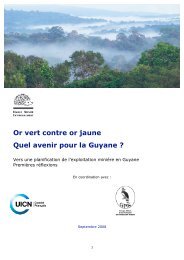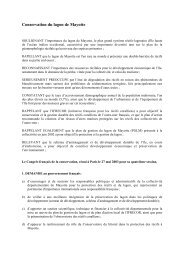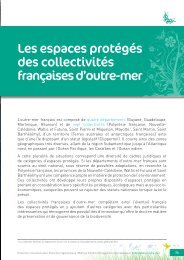Establishing Marine Protected Area Networks - Georgia Strait Alliance
Establishing Marine Protected Area Networks - Georgia Strait Alliance
Establishing Marine Protected Area Networks - Georgia Strait Alliance
You also want an ePaper? Increase the reach of your titles
YUMPU automatically turns print PDFs into web optimized ePapers that Google loves.
for the environment.This complexity is often exacerbated<br />
by the fact that government agencies may<br />
have different-and even opposing–mandates.<br />
❏ Develop the legal authorities and institutional<br />
frameworks needed to deliver MPA networks.<br />
Where agency responsibilities and authorities overlap,<br />
participants will need to clarify responsibilities<br />
or elect one of the parties to play a leadership<br />
role. Effective coordination across agencies requires<br />
sustained leadership, either by one agency or a<br />
specially formed committee or council that can<br />
coordinate overlapping and complex jurisdictional<br />
arrangements. Complementary and/or consistent<br />
legal and institutional frameworks can help resolve<br />
inconsistencies where jurisdictions or institutional<br />
responsibilities overlap.<br />
❏ Clarify the legal framework for developing<br />
MPA networks. Many countries have special or<br />
single-purpose legislation enabling individual MPAs,<br />
and often a variety of agencies share responsibilities<br />
for these areas. Only a few have legislative or institutional<br />
arrangements that provide a comprehensive<br />
basis for an MPA network.A poorly integrated<br />
array of legal and institutional responsibilities can<br />
lead to problems such as competing mandates,<br />
overlaps, gaps and inefficiencies.<br />
❏ Recognize that the diversity and capacity<br />
of the institutions and other groups involved<br />
in developing MPA networks can influence the<br />
network’s efficacy. It is rare for a single agency<br />
to have complete authority over a comprehensive<br />
MPA network.To develop effective arrangements<br />
for MPA governance, planners must consider the<br />
environmental and ecological circumstances, the<br />
cultural and socio-political context, and the economic<br />
and logistical aspects of management.<br />
Creating an MPA network can proceed only as<br />
quickly as the institutions and individuals responsible<br />
for key functions develop the skills and attributes<br />
needed to manage the network and its component<br />
MPAs well. Frequently, existing organizations will<br />
need to take on new and different roles; sometimes,<br />
entirely new institutions will need to be created to<br />
oversee or coordinate activities at the network level.<br />
❏ Promote trans-boundary MPA networks as<br />
instruments for shared management, conservation<br />
and cooperation. Ecosystems, habitats and species<br />
rarely correspond to political or jurisdictional boundaries.Therefore,<br />
they require cooperative management<br />
among states, regions, nations, and jurisdictions.<br />
Trans-boundary protected areas, those that straddle<br />
the boundaries of jurisdiction and sovereignty and<br />
often involve high-level political initiatives, represent<br />
one strategy for cooperative management.<br />
10 | <strong>Establishing</strong> <strong>Marine</strong> <strong>Protected</strong> <strong>Area</strong> <strong>Networks</strong>
















